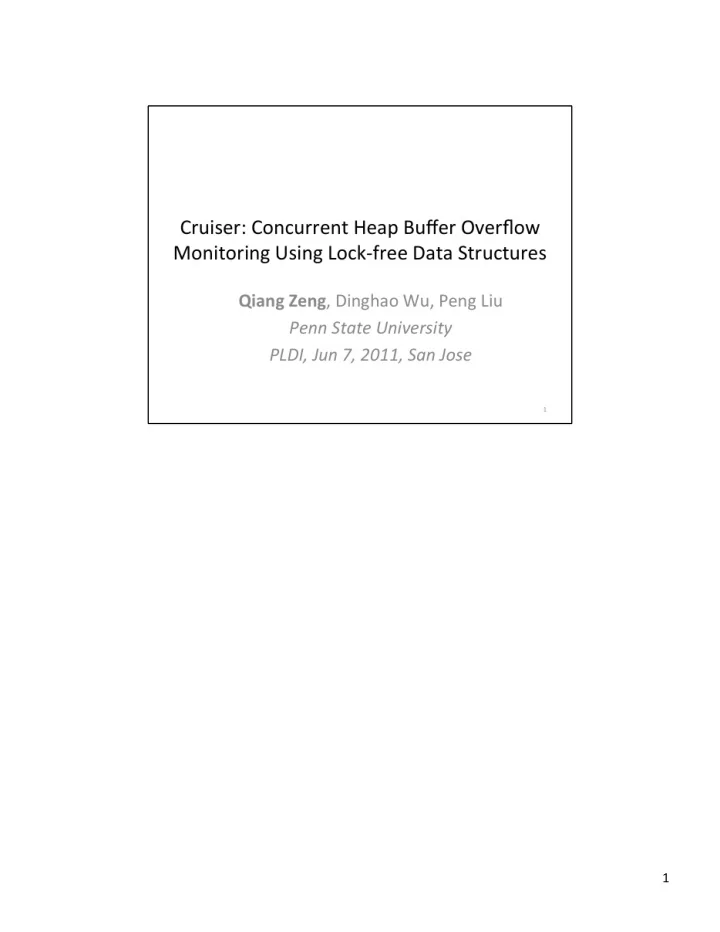

1 ¡
Despite ¡extensive ¡research ¡over ¡the ¡past ¡few ¡decades, ¡buffer ¡overflows ¡remain ¡as ¡ one ¡of ¡the ¡top ¡so:ware ¡vulnerabili<es. ¡In ¡2009, ¡39% ¡of ¡the ¡vulnerabili<es ¡published ¡ by ¡US-‑CERT ¡were ¡related ¡to ¡buffer ¡overflows. ¡There ¡are ¡mainly ¡two ¡types ¡of ¡buffer ¡ overflows: ¡stack-‑based ¡and ¡heap-‑based. ¡Many ¡effec<ve ¡countermeasures ¡against ¡ stack-‑based ¡buffer ¡overflows ¡have ¡been ¡devised; ¡some ¡of ¡them ¡have ¡been ¡widely ¡ deployed, ¡such ¡as ¡StackGuard. ¡As ¡stack-‑based ¡buffer ¡overflows ¡have ¡been ¡beSer ¡ understood ¡and ¡defended, ¡heap-‑based ¡buffer ¡overflows ¡gain ¡growing ¡aSen<on ¡of ¡ aSackers. ¡Related ¡exploits ¡have ¡affected ¡some ¡well-‑known ¡programs, ¡such ¡as ¡ Microso: ¡Data ¡Access ¡Component ¡and ¡the ¡SQL ¡Server. ¡ ¡ 2 ¡
Exis<ng ¡dynamic ¡heap ¡buffer ¡overflow ¡detectors ¡can ¡be ¡roughly ¡divided ¡into ¡three ¡ categories ¡according ¡to ¡the ¡overflow ¡checking ¡occasions. ¡The ¡first ¡category ¡associates ¡ a ¡buffer ¡boundary ¡lookup ¡with ¡each ¡pointer ¡dereference, ¡which ¡typically ¡imposes ¡ <mes ¡of ¡performance ¡overhead. ¡The ¡second ¡category ¡checks ¡buffer ¡overflows ¡in ¡ specific ¡libc ¡func<ons, ¡such ¡as ¡strcpy ¡and ¡gets. ¡Buffer ¡overflows ¡exis<ng ¡in ¡other ¡ func<ons ¡are ¡ignored, ¡thus ¡they ¡have ¡evident ¡spa<al ¡limita<ons. ¡ The ¡third ¡category ¡checks ¡buffer ¡overflows ¡when ¡a ¡buffer ¡is ¡allocated, ¡deallocated ¡or ¡ combined. ¡However, ¡the ¡vulnerability ¡may ¡have ¡been ¡exploited ¡much ¡earlier ¡than ¡the ¡ checking. ¡The ¡common ¡characteris<c ¡of ¡these ¡detectors ¡is ¡inlined ¡security ¡checking, ¡ which ¡either ¡delays ¡program ¡execu<on ¡too ¡much ¡or ¡has ¡spa<al ¡or ¡temporal ¡ limita<ons. ¡ ¡ ¡ ¡ ¡ ¡ 3 ¡
As ¡we ¡can ¡see ¡in ¡this ¡graph, ¡the ¡inlined ¡security ¡checking ¡and ¡the ¡normal ¡program ¡ execu<on ¡are ¡in ¡a ¡sequen<al ¡order. ¡Nowadays ¡mul<core ¡architectures ¡are ¡more ¡and ¡ more ¡popular. ¡We ¡intended ¡to ¡move ¡the ¡inlined ¡security ¡checking ¡from ¡the ¡program ¡ to ¡a ¡separate ¡monitor ¡thread, ¡so ¡that ¡the ¡delay ¡due ¡to ¡security ¡checking ¡can ¡be ¡ largely ¡eliminated. ¡In ¡addi<on, ¡the ¡monitor ¡thread ¡can ¡cruise ¡over ¡the ¡process ¡ concurrently ¡over ¡and ¡again ¡at ¡a ¡high ¡frequency ¡throughout ¡the ¡process ¡lifecycle. ¡ With ¡mul<core ¡architectures, ¡the ¡addi<onal ¡cost ¡for ¡running ¡a ¡separate ¡monitor ¡ thread ¡is ¡liSle. ¡In ¡addi<on, ¡because ¡the ¡major ¡opera<on ¡of ¡monitoring ¡is ¡read, ¡the ¡ performance ¡overhead ¡can ¡be ¡very ¡low, ¡as ¡long ¡as ¡the ¡synchroniza<on ¡between ¡user ¡ threads ¡and ¡the ¡monitor ¡thread ¡is ¡light-‑weight. ¡On ¡the ¡other ¡hand, ¡if ¡the ¡ synchroniza<on ¡overhead ¡is ¡high, ¡the ¡benefits ¡gained ¡from ¡concurrent ¡monitoring ¡ may ¡be ¡offset ¡by ¡the ¡synchroniza<on ¡overhead, ¡so ¡it ¡is ¡cri<cal ¡also ¡challenging ¡to ¡ keep ¡the ¡synchroniza<on ¡overhead ¡low. ¡We ¡call ¡this ¡concurrent ¡monitoring ¡ technique ¡with ¡light-‑weight ¡synchroniza<on ¡as ¡So:ware ¡Cruising. ¡ 4 ¡
In ¡our ¡work, ¡each ¡heap ¡buffer ¡is ¡enclosed ¡by ¡a ¡pair ¡of ¡canaries; ¡Whenever ¡a ¡buffer ¡is ¡overflowed, ¡its ¡ canary ¡is ¡first ¡corrupted. ¡So ¡once ¡a ¡canary ¡is ¡found ¡tampered, ¡a ¡buffer ¡overflow ¡is ¡detected. ¡The ¡classic ¡ canary-‑based ¡buffer ¡overflow ¡checking ¡was ¡first ¡proposed ¡in ¡Stackguard. ¡ To ¡the ¡end ¡of ¡concurrent ¡monitoring, ¡one ¡task ¡is ¡to ¡collect ¡canary ¡addresses ¡into ¡some ¡efficient ¡data ¡ structures. ¡Specifically ¡the ¡malloc/free ¡calls ¡in ¡user ¡threads ¡are ¡hooked ¡to ¡insert ¡and ¡delete ¡canary ¡ addresses ¡respec<vely, ¡in ¡the ¡meanwhile ¡the ¡monitor ¡thread ¡traverses ¡the ¡data ¡structure ¡to ¡locate ¡ and ¡check ¡canaries ¡in ¡an ¡infinite ¡loop. ¡However ¡there ¡are ¡a ¡series ¡of ¡poten<al ¡race ¡condi<ons ¡here, ¡for ¡ example ¡when ¡the ¡monitor ¡thread ¡checks ¡a ¡buffer, ¡the ¡buffer ¡may ¡have ¡been ¡deallocated, ¡and ¡the ¡ buffer ¡memory ¡may ¡have ¡been ¡unmapped; ¡Also ¡the ¡concurrent ¡canary ¡address ¡inser<on ¡and ¡removal ¡ are ¡hazardous. ¡Therefore, ¡some ¡concurrent ¡data ¡structures ¡are ¡needed ¡here. ¡ ¡ We ¡first ¡tried ¡a ¡lock-‑based ¡red-‑black ¡tree. ¡The ¡performance ¡and ¡scalability ¡are ¡not ¡sa<sfactory, ¡ because ¡user ¡threads ¡are ¡blocked ¡by ¡the ¡monitor ¡thread ¡frequently ¡due ¡to ¡lock ¡conten<on. ¡So ¡we ¡ turned ¡to ¡non-‑blocking ¡synchroniza<on ¡and ¡lock-‑free ¡data ¡structures. ¡ In ¡the ¡second ¡aSempt, ¡we ¡u<lized ¡a ¡state-‑of-‑the ¡art ¡lock-‑free ¡hash ¡table. ¡In ¡theory ¡the ¡inser<on ¡and ¡ removal ¡opera<ons ¡can ¡be ¡finished ¡in ¡constant ¡<me ¡and ¡there ¡is ¡no ¡blocking. ¡However, ¡our ¡ experiments ¡show ¡that ¡the ¡performance ¡overhead ¡is ¡very ¡high: ¡the ¡<me ¡for ¡a ¡pair ¡of ¡malloc ¡and ¡free ¡ calls ¡is ¡more ¡than ¡5 ¡<mes. ¡One ¡reason ¡is ¡the ¡complex ¡data ¡structure ¡opera<ons; ¡another ¡reason ¡is ¡the ¡ conten<on ¡between ¡the ¡user ¡threads ¡and ¡the ¡monitor ¡thread. ¡It ¡shows ¡that ¡non-‑blocking ¡is ¡not ¡magic; ¡ it ¡usually ¡requires ¡the ¡power ¡of ¡efficient, ¡and ¡some<mes ¡specialized, ¡lock-‑free ¡data ¡structures. ¡ 5 ¡
The ¡major ¡challenge ¡for ¡concurrent ¡monitoring ¡is ¡synchroniza<on ¡overhead. ¡ According ¡to ¡the ¡experience ¡in ¡the ¡failed ¡aSempts, ¡to ¡achieve ¡light-‑weight ¡ synchroniza<on, ¡user ¡threads ¡should ¡not ¡be ¡blocked ¡by ¡the ¡monitor ¡thread; ¡second, ¡ custom ¡lock-‑free ¡data ¡structures ¡should ¡be ¡designed ¡for ¡good ¡performance ¡and ¡ scalability. ¡ 6 ¡
This ¡is ¡the ¡architecture ¡of ¡Cruiser. ¡The ¡le: ¡part ¡shows ¡the ¡interposi<on ¡of ¡the ¡malloc ¡ func<on ¡family, ¡such ¡that ¡Cruiser ¡is ¡able ¡to ¡collect ¡canary ¡addresses. ¡The ¡middle ¡part ¡ is ¡the ¡canary ¡address ¡collec<on ¡component, ¡which ¡contains ¡our ¡custom ¡lock-‑free ¡ data ¡structures; ¡the ¡details ¡will ¡be ¡presented ¡later. ¡The ¡right ¡part ¡is ¡the ¡monitor ¡ thread, ¡which ¡traverses ¡the ¡lock-‑free ¡data ¡structure ¡to ¡perform ¡concurrent ¡buffer ¡ overflow ¡checking. ¡We ¡will ¡present ¡the ¡data ¡structures ¡and ¡how ¡the ¡canary ¡addresses ¡ are ¡collected ¡in ¡a ¡non-‑blocking ¡and ¡efficient ¡fashion. ¡ 7 ¡
Recommend
More recommend